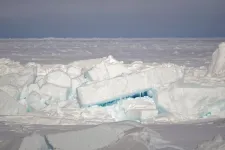(Press-News.org) 2024 was another year of record-breaking temperatures, driving the global water cycle to new climate extremes and contributing to ferocious floods and crippling droughts, a new report led by The Australian National University (ANU) shows.
The 2024 Global Water Monitor Report, involving an international team of researchers and led by ANU Professor Albert van Dijk, found rising temperatures are changing the way water moves around the planet, “wreaking havoc” on the water cycle.
“Rising sea surface temperatures intensified tropical cyclones and droughts in the Amazon Basin and southern Africa. Global warming also contributed to heavier downpours and slower-moving storms, as evidenced by deadly flash floods in Europe, Asia and Brazil,” Professor van Dijk said.
In 2024, about four billion people across 111 countries – half of the world’s population − experienced their warmest year yet. Professor van Dijk said air temperatures over land in 2024 were 1.2 degrees Celsius warmer than at the start of the century, and about 2.2 degrees Celsius higher than at the start of the Industrial Revolution.
“In 2024, Earth experienced its hottest year on record, for the fourth year in a row. Water systems across the globe bore the brunt,” he said.
“2024 was a year of extremes but was not an isolated occurrence. It is part of a worsening trend of more intense floods, prolonged droughts, and record-breaking extremes.”
The most damaging water-related disasters in 2024 included flash floods, river floods, droughts, tropical cyclones and landslides. Water-related disasters killed more than 8,700 people, displaced 40 million people and caused economic losses exceeding US $550 billion.
“From historic droughts to catastrophic floods, these extreme events impact lives, livelihoods, and entire ecosystems. Separate, heavy rainfall events caused widespread flash flooding in Afghanistan and Pakistan, killing more than 1,000 people,” Professor van Dijk said.
“Catastrophic flooding in Brazil caused more than 80 deaths, with the region recording more than 300 millimetres of rainfall.
“We found rainfall records are being broken with increasing regularity. For example, record-high monthly rainfall totals were achieved 27 per cent more frequently in 2024 than at the start of this century, whereas daily rainfall records were achieved 52 per cent more frequently. Record-lows were 38 per cent more frequent, so we are seeing worse extremes on both sides.
“In southern China, the Yangtze and Pearl Rivers flooded cities and towns, displacing tens of thousands of people and causing hundreds of millions of dollars in crop damages.
“In Bangladesh in August, heavy monsoon rains and dam releases in August caused widespread river flooding. More than 5.8 million people were affected and at least one million tonnes of rice was destroyed. In Spain, more than 500 millimetres of rain fell within eight hours in late October, causing deadly flash floods.”
While some parts of the world experienced major flooding in 2024, others endured crippling drought.
“In the Amazon Basin, one of the Earth’s most important ecosystems, record low river levels cut off transport routes and disrupted hydropower generation. Wildfires driven by the hot and dry weather burned through more than 52,000 square kilometres in September alone, releasing vast amounts of greenhouse gases,” Professor van Dijk said.
“In southern Africa, a severe drought reduced maize production by more than 50 per cent, leaving 30 million people facing food shortages. Farmers were forced to cull livestock as pastures dried up. The drought also reduced hydropower output, leading to widespread blackouts.
“We need to prepare and adapt to inevitably more severe extreme events. That can mean stronger flood defences, developing more drought-resilient food production and water supplies, and better early warning systems.
“Water is our most critical resource, and its extremes—both floods and droughts—are among the greatest threats we face.”
The research team used data from thousands of ground stations and satellites orbiting the Earth to deliver near real-time insights into critical water variables such as rainfall, soil moisture, river flows, and flooding.
The Global Water Monitor is a collaboration between institutions across the world and involves various public and private organisations.
The 2024 report is available on the Global Water Monitor website.
END
Climate extremes in 2024 ‘wreaking havoc’ on the global water cycle
2025-01-06
ELSE PRESS RELEASES FROM THIS DATE:
Acoustic sensors find frequent gunfire on school walking routes
2025-01-06
COLUMBUS, Ohio – A new study used acoustic sensors that detect the sound of gunfire to show how often children in one Chicago neighborhood are exposed to gunshots while walking to and from school.
Results showed that nearly two-thirds of schools in the Englewood neighborhood of Chicago had at least one gun incident within 400 meters (about one-quarter mile) of where children were walking home during the 2021-22 school year.
These findings suggest a need to redefine federal definitions of school gun violence to include indirect forms of violence that take place near schools, not only on school grounds, in order to more appropriately ...
New quantum sensing technology reveals sub-atomic signals
2025-01-06
Since the 1950s, scientists have used radio waves to uncover the molecular “fingerprints” of unknown materials, aiding in tasks as varied as scanning the human body with MRI machines and detecting explosives at airports.
These methods, however, rely on signals averaged from trillions of atoms, making it impossible to detect tiny variations between individual molecules. Such limitations hinder applications in fields like protein research, where small differences in shape control functionality and can determine the difference between health and disease.
Sub-Atomic Insights
Now, engineers at the University of Pennsylvania ...
Significant funding to ensure personalized treatments that work for rheumatoid arthritis
2025-01-06
In recent years treatment with powerful biologic and targeted synthetic therapies has changed the landscape for arthritis, but currently finding the right treatment for each person is a matter of trial and error. Only a proportion of patients with inflammatory arthritis respond to each expensive therapy, which results in unnecessary treatment and a long and often frustrating journey for patients, not to mention significant cost to the NHS.
University of Birmingham researchers have just been awarded £3.5 million funding from Johnson & Johnson to investigate ...
CryoSCAPE: Allen Institute scientists develop ‘suspended animation’ technique for blood draws that will aid research for underserved populations
2025-01-06
By Rachel Tompa, Ph.D
Your blood is a delicate mixture. Researchers and clinicians often use blood to learn what’s going on inside our bodies, in part because siphoning off a tube of blood is easier and less painful than taking biopsies of an internal organ.
But in some cases, it turns out that blood can be very different outside our bodies. When it comes to certain emerging research techniques, the clock starts ticking as soon as your blood hits the tube. As little as six to eight hours later, some aspects of your blood’s ...
Prime apple growing areas in US face increasing climate risks
2025-01-06
VANCOUVER, Wash. – Some of the most productive apple regions in America are facing big challenges from a changing climate, according to a Washington State University study.
Researchers analyzed over 40 years of climate conditions that impact the growth cycle of apple trees from bud break and flowering through fruit development, maturation and color development.
While many growing areas are facing increased climate risks, the top three largest apple producing counties in the U.S. were among the most impacted: Yakima in Washington, Kent in Michigan and Wayne ...
Extended Paxlovid may help some people with long COVID
2025-01-06
An up-close look at how patients respond to the drug at different times and doses adds nuance to a recent finding that Paxlovid does not work for long Covid.
An extended course of Paxlovid appears to help some patients with long Covid, according to a case series by UC San Francisco researchers that suggests this treatment option holds promise for some of those struggling with debilitating symptoms.
These results are at odds with recent research that has failed to show the antiviral can alleviate persistent symptoms of the disease. The authors said more study is needed to find out which patients may benefit from the drug and how long it should be given.
The ...
Media coverage of civilian casualties in allied countries boosts support for U.S. involvement
2025-01-06
From photographs of decimated buildings to military and civilian casualty counts to narratives of suffering, news media bring information about foreign conflicts to American audiences. But does this coverage actually affect public opinion about whether and how the United States should be involved in a conflict? Does it influence what Americans think about the U.S. providing military, diplomatic, and economic aid to foreign nations?
A new paper from researchers at the Annenberg Public Policy Center (APPC) of the University of Pennsylvania examines these questions and finds that media coverage of civilian casualties increases public support for U.S. involvement in conflicts by evoking empathy ...
Marked decrease in Arctic pressure ridges
2025-01-06
In the Arctic, the old, multiyear ice is increasingly melting, dramatically reducing the frequency and size of pressure ridges. These ridges are created when ice floes press against each other and become stacked, and are a characteristic feature of Arctic sea ice, an obstacle for shipping, but also an essential component of the ecosystem. In a recently released study in the journal Nature Climate Change, experts from the Alfred Wegener Institute report on this trend and analyse observational data from three decades of aerial surveys.
Satellite data from the last three decades documents the dramatic changes in Arctic sea ice due to climate change: the area covered in ice in summer ...
Age matters: Kidney disorder indicator gains precision
2025-01-06
Annual health checkups regularly include urine tests that serve several purposes, including checking for symptoms of kidney disease. The presence of albumin in the urine is one indicator as is glomerular filtration rate. In diabetic nephropathy, albuminuria first appears, leading to excessive filtration and eventually a decrease in GFR.
In the elderly, however, excessive filtration cannot be detected due to age-related GFR decline. To accurately assess GFR, Osaka Metropolitan University researchers have come up with ...
New guidelines for managing blood cancers in pregnancy
2025-01-04
A new set of guidelines has been developed to assist with the diagnosis and expert management of serious blood cancers in pregnancy.
About 12.5 pregnancies per 100,000 are affected by blood cancers such as acute leukaemia and aggressive lymphomas, and their incidence has been rising.
Between 1994 and 2013, they increased by 2.7 per cent a year, due to factors including women having children later, improved diagnostic techniques, and increased health system engagement.
An Australian working group has now published a new position statement in the latest edition of The Lancet Haematology, based on current evidence and expert consensus.
It ...




